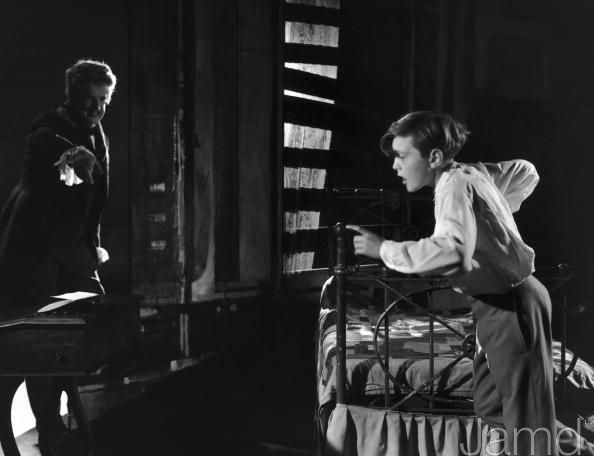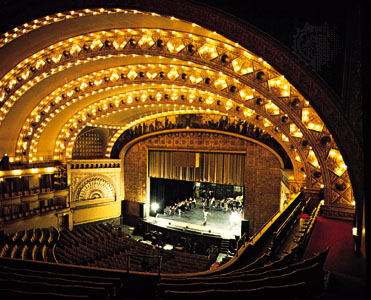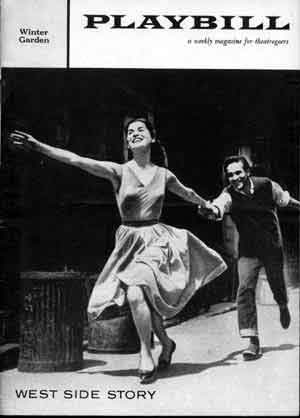 The news that the Metropolitan Opera has decided to trim its budget by scrapping its revival of The Ghosts of Versailles set me to thinking about the problem of producing new operas that are conceived on a large scale. Such operas do get written–John Adams, for one, has had exceptionally good luck with the genre–but they tend not to get revived all that often. Conversely, a not-inconsiderable percentage of the operas written since 1945 that have had a healthy revival life are “chamber operas” like Benjamin Britten’s The Turn of the Screw and Gian Carlo Menotti’s The Medium that were specifically designed for performance by small companies.
The news that the Metropolitan Opera has decided to trim its budget by scrapping its revival of The Ghosts of Versailles set me to thinking about the problem of producing new operas that are conceived on a large scale. Such operas do get written–John Adams, for one, has had exceptionally good luck with the genre–but they tend not to get revived all that often. Conversely, a not-inconsiderable percentage of the operas written since 1945 that have had a healthy revival life are “chamber operas” like Benjamin Britten’s The Turn of the Screw and Gian Carlo Menotti’s The Medium that were specifically designed for performance by small companies.
The trouble with chamber operas is that they usually can’t be produced in a large auditorium, at least not very effectively. The Medium is an hour-long opera performed on a single set by a cast of five singers and an actor and accompanied by a fourteen-piece orchestra. You can make it work in a Broadway-sized theater–indeed, The Medium ran for seven months in the 1,100-seat Ethel Barrymore Theatre in 1947–but it feels a size or two too small when performed in most opera houses.
This isn’t a hard-and-fast rule. Mark Lamos’ staging of The Turn of the Screw was presented in 1996 by the New York City Opera in the 2,800-seat New York State Theater, and you never felt for a moment that the opera was dwarfed by the house. As I wrote in the New York Daily News two days after the opening:
Right from the start, this Turn of the Screw grabs you by the throat and doesn’t let go. Mark Lamos’ staging, surrealistically designed by John Conklin and lit with the flat, bright clarity of a nightmare by Robert M. Wierzel, emphasizes the horror-show aspects of the opera without descending into bathos or camp. Lamos has an uncanny knack for directing singers–I can’t remember the last time I saw better operatic acting.
Twelve years later, Lamos’ Turn of the Screw remains the most exciting production of that great opera that I’ve had the luck to see–but the fact remains that it was it was conceived for Glimmerglass Opera’s wonderfully intimate 910-seat Alice Busch Opera Theater in Cooperstown, New York, and I suspect that it packed an even bigger punch there than it did at Lincoln Center.
 America’s opera houses range in size from the monstrous to the petite. The Lyric Opera of Chicago performs in the 4,300-seat Auditorium Theatre, while the Metropolitan Opera House holds 3,800 people. At the other end of the spectrum is New York’s Amato Opera House, which has 107 seats. Most American houses, however, fall somewhere in between these extremes. The Kennedy Center Opera House, home of the Washington National Opera, has 2,200 seats, 75 more than the Santa Fe Opera’s Crosby Theater, where The Letter, the opera that I’m writing with Paul Moravec, will be premiered next July.
America’s opera houses range in size from the monstrous to the petite. The Lyric Opera of Chicago performs in the 4,300-seat Auditorium Theatre, while the Metropolitan Opera House holds 3,800 people. At the other end of the spectrum is New York’s Amato Opera House, which has 107 seats. Most American houses, however, fall somewhere in between these extremes. The Kennedy Center Opera House, home of the Washington National Opera, has 2,200 seats, 75 more than the Santa Fe Opera’s Crosby Theater, where The Letter, the opera that I’m writing with Paul Moravec, will be premiered next July.
What sort of opera do you write for such large but not elephantine houses–and is it possible to write it in such a way that it can also be successfully staged in smaller theaters? As I mentioned the other day, the original proposal for The Letter that Paul and I made to the Santa Fe Opera was explicit on this point:
Our goal is to write an opera whose casting and scenic requirements are compatible with the needs of medium-sized regional houses but which is musically “big” enough to work just as well in large houses.
Hence The Letter, a ninety-minute-long opera with five major roles, two smaller but dramatically essential roles, and a chorus of a dozen men who also cover a number of minor parts. It calls for five simple sets that can be changed quickly and in full view of the audience: a living room, a lawyer’s office, a jail cell, the bar of the Singapore Club, and a courtroom. Paul is scoring The Letter for a full-sized pit orchestra, but he also plans to prepare a second version suitable for performance by a smaller group.
 The Letter, in short, should be well within the means of most regional companies. At the same time, though, the opera’s emotional scale and musical gestures are anything but small. The next-to-last scene, for instance, takes place in the courtroom where Leslie Crosbie, the character played by Bette Davis in the 1940 film version of The Letter, is being tried for murder. It’s a churning, propulsive ensemble inspired by the “Tonight Quintet” from West Side Story, and even though there will only be sixteen singers on stage, it’s going to get loud.
The Letter, in short, should be well within the means of most regional companies. At the same time, though, the opera’s emotional scale and musical gestures are anything but small. The next-to-last scene, for instance, takes place in the courtroom where Leslie Crosbie, the character played by Bette Davis in the 1940 film version of The Letter, is being tried for murder. It’s a churning, propulsive ensemble inspired by the “Tonight Quintet” from West Side Story, and even though there will only be sixteen singers on stage, it’s going to get loud.
If I had to guess, I’d say that The Letter will be a bit too small for the Metropolitan Opera House, but it ought to fit quite nicely into the Crosby Theater–though the Met, lest we forget, has a long history of presentng such compact works as Mozart’s Così fan tutte, which calls for for six singers and a smallish chorus and orchestra, alongside grander-than-grand operas like Otello and Turandot. Might our not-so-little melodrama eventually turn up there as well, especially now that the Met’s management has become newly cost-conscious? I doubt it, but stranger things have happened…
UPDATE: Two friends wrote to point out what I knew perfectly well but somehow managed to forget, which is that the Chicago Lyric Opera performs not in the Auditorium Theatre but in the Civic Opera House, which has 3,600 seats, a couple of hundred fewer than the Metropolitan Opera House. Big, in other words, but not super-big.
My apologies.
